Ijraset Journal For Research in Applied Science and Engineering Technology
- Home / Ijraset
- On This Page
- Abstract
- Introduction
- Conclusion
- References
- Copyright
Seismic Behavior of Structures with Different Cantilever Projections in Different Zones
Authors: Dhanshree Nandanwar, Dr. Umesh Pendharkar
DOI Link: https://doi.org/10.22214/ijraset.2023.55991
Certificate: View Certificate
Abstract
This research paper focuses on studying how structures with different cantilever projections (1m, 1.25m, and 1.5m) behave during seismic events in different seismic zones. The analysis is conducted for both 5-story and 10-story buildings, following the guidelines provided in IS 1893 (Part 1):2016. The static method is used to assess various parameters, including story drift, frequency and time period in ETABS software. By examining these factors, we can better understand how these structures perform under seismic forces.
Introduction
I. INTRODUCTION
Seismic behavior refers to the response of buildings and infrastructure to the ground motion generated by earthquakes. It encompasses a wide spectrum of phenomena, from structural integrity and stability to the safety of occupants and the preservation of property. Central to comprehending seismic behavior is the recognition that seismic hazards are not uniformly distributed across the globe; instead, they vary significantly from one geographic region to another. To address these regional variations in seismic risk, areas around the world are categorized into different seismic zones or seismic hazard zones. These zones are delineated based on the local geological, geophysical, and seismological conditions, which collectively govern the likelihood and intensity of seismic events. Each seismic zone is characterized by its unique seismic hazard level, specifying the ground motion acceleration that structures in that region may experience during an earthquake. The seismic behavior of structures is profoundly influenced by the seismic zone in which they are situated. Buildings and infrastructure in high seismic hazard zones must be engineered to withstand more severe ground motions, necessitating robust and innovative design approaches. In contrast, regions with lower seismic hazard levels may permit more relaxed design criteria.
II. LITERATURE REVIEW
- Arunava Das, Priyabrata Guha (2016) finds response of regular and irregular structures by nonlinear static analysis and nonlinear dynamic analysis. The study includes the Pushover Analysis and Non-linear Time History Analysis of four legendary regular and irregular structures in SAP 2000 platform. Four legendary R.C. structures with Case I – regular plan and Case II – Irregular plan are considered for seismic analysis. it's observed that the deportation attained by static analysis are advanced than dynamic analysis for irregular Time History analysis should be performed as it predicts the structural response more directly in comparison with Pushover Analysis structure and deportation attained by dynamic analysis are advanced than stationary analysis for regular structure.
- Sampath Nagod,Prof.A.J. Zende (2017) perform such an analysis, a representative earthquake time history is demanded for the structure being estimated. In this present work non-direct dynamic analysis of 12 legendary RC structure having mass irregularity considering Bhuj earthquake time history is carried out using ETABS software. also, Lead Rubber Bearing is manually designed and hermit parcels are assigned to the structure. various parameters like Base shear, Time period and Story deportation are determined for regular and mass irregular structures with fixed base and base insulated condition and compared with each other. In this study, 12 fabulous corroborated concrete structure with and without base sequestration are considered. In addition to that, mass irregularity is also taken into consideration by furnishing heavy mass at 11th bottom. Time history analysis is performed on structures using ETABS software.
- Abhay Guleria (2014) the case study in this paper substantially emphasizes on structural geste of multi-story structure for different plan configurations like blocky, C, L and I- shape. Modelling of 15- stories R.C.C. framed structure is done on the ETABS software for analysis. Post analysis of the structure, maximum shear forces, bending moments, and maximum story expatriation are reckoned and also compared for all the anatomized cases. L- shape, I- shape type structures give nearly analogous response against the capsizing moment. it can be concluded that asymmetrical plans suffer further distortion than symmetrical plans.
- Sanisha Santhosh, Linda Ann Mathew (2017), studied on the enhancement shape of shear walls in symmetrical high-rise structure. In symmetrical structures, the center of graveness and center of severity coincide, so that the shear walls are placed symmetrically. In this work a high-rise structure with different shapes of shear walls is considered for analysis. The multistory structure with G+14 and G+29 stories is anatomized for its story drift and base shear using ETABS software. For the analysis of the structure for seismic lading with two different Zones (Zone- III & Zone- V) is considered. The analysis of the structure is done by using dynamic system (Response diapason analysis).
- Shobha R, Vinod BR, Vivek Vedant, Jagdish Suthar B, Pawan Bhatia, Joell Binu P (2021) studied about the multi-story seismic analysis will proceed in two stages- Performance differentiation of a reinforced concrete structure for all present seismic regions in India i.e., II(Two), III(Three), IV(Four), and V(Five) and Analysis of factors like base shear, story drift and story displacement of designed structure for various seismic sectors. Analysis of desired structure is done using ETABS and response spectrum analysis is considered for the different seismic regions, there’s gradual increase in the base shear and lateral displacement in the structure. The drift is observed to be increasing with increase in story levels.
- RAJU MUDDASANI, NAVJOT KAUR BHATIA (2023), the effect of seismic forces on structures with different vertical figure arrangements have been analyzed by exercising ETABS software. Analysis and design are done as per IS456- 2000. M30 grade of concrete and Fe- 500 brand is espoused. weight combinations are taken as per IS 875- part 5 (2015). There are several enterprises which affect the performance of structure from which story shear and story deportation play a vital part in chancing the behavior of structure against the seismic loads. Story deportation increased with story height. The deportation decreases as the vertical irregularity increases.
- Ravi Kumar Vishwakarma, Vipin Kumar Tiwari (2021), presents the literature review of colorful studies done before on the factors which affect the performance of shear walls similar as position of shear walls. It's studied that maximum relegation and story drift value are set up to be advanced in seismic zone V as compared to other zones. Seismic zone II, III and VI which indicate the relegation can be reduced by making structure with invariant stiffness. It was observed that erecting with varying consistence in dwindling order throughout the height at middle external span achieves loftiest reduction in relegation due to increased side stiffness and drop in seismic weight of the structure.
- Asadullah Dost, Asst.Prof. Anil Kumar Chaudhary (2021) The primary thing of this exploration is to conduct an earthquake analysis of G+15, G+20, and G+25 domestic structures using Indian standard canons of practice IS 1893 (Part 1) 2002. The member forces are calculated using cargo combinations according to IS 456 2000's Limit State Method. According to IS 875 (Part 1, Part 2) 1987, the structure is subordinated to dead cargo, tone- weight, and live cargo. With the help of the ETAB software, the structure was designed in agreement with seismic law IS- 18932002 under seismic zone IV. Response diapason and seismic response of the structures are studied by ETABS 2018 using dynamic analysis.
III. METHODOLOGY
Seismic analysis is a critical aspect of structural engineering that involves evaluating the response of structures to earthquakes and ground motion. The analysis aims to ensure the safety and stability of buildings and other structures during seismic events. Seismic analysis methods can be broadly categorized into static and dynamic procedures.
A. Static Seismic Analysis
Static seismic analysis methods provide simplified but conservative approximations of the seismic forces that a structure might experience during an earthquake. These methods are often used for straightforward structures and include:
- Equivalent Static Lateral Force Procedure
- Pushover Analysis (Static Nonlinear Analysis)
B. Dynamic Seismic Analysis
Dynamic seismic analysis methods consider the time-varying characteristics of ground motion and a structure's response to them. These methods are typically employed for complex or tall structures and include:
- Response Spectrum Analysis
- Time History Analysis
- Modal Response Spectrum Analysis
Out of these methods we are using only Equivalent Static Lateral Force Procedure. This method allows us to estimate the forces that an earthquake will exert on a structure. It simplifies the analysis by using a single, equivalent force that represents the overall effect of the earthquake. By applying this force to the structure, we can design it to withstand the seismic forces and ensure its safety. Another important aspect is following the IS:1893:(Part-1):2016 code, which provides guidelines for seismic design in India. This code, issued by the Bureau of Indian Standards (BIS), is a comprehensive document that covers various aspects of seismic design and construction, including:
a. Seismic Zoning: The code classifies different regions of India into seismic zones based on their vulnerability to earthquakes. It provides guidelines for designing structures according to the seismic zone in which they are located.
b. Load Combinations: IS: 1893 (Part-1):2016 outlines the load combinations and factors to consider when designing structures for earthquake loads, including dead loads, live loads, and seismic forces.
c. Structural Design: The code provides design criteria for various types of structures, such as buildings, bridges, and industrial structures, to ensure they can withstand earthquake forces.
d. Material Specifications: It includes specifications for materials commonly used in construction to ensure they meet seismic design requirements.
e. Foundation Design: Guidelines for the design of foundations to withstand seismic forces are included in the code.
f. Retaining Structures: The code also addresses the design of retaining structures and their stability during earthquakes.
g. Non-Structural Components: IS: 1893 (Part-1):2016 provides recommendations for the earthquake-resistant design of non-structural components, such as cladding, partitions, and mechanical and electrical systems.
Overall, IS: 1893 (Part-1):2016 is a crucial document for engineers and architects in India, providing standards and practices to enhance the earthquake resistance of structures and improve public safety during seismic events.


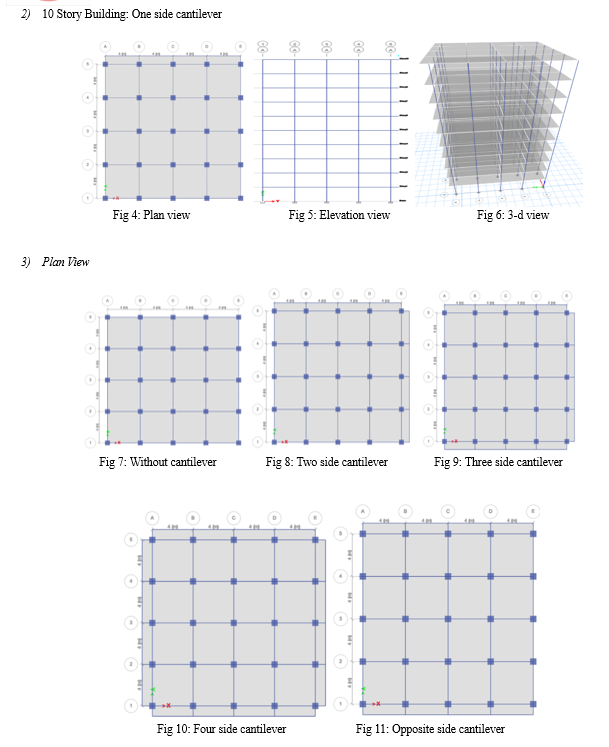
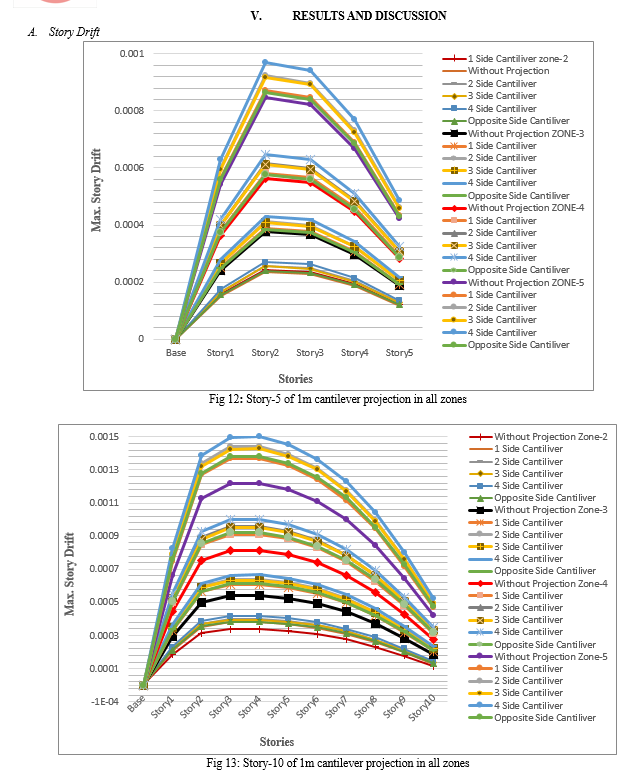
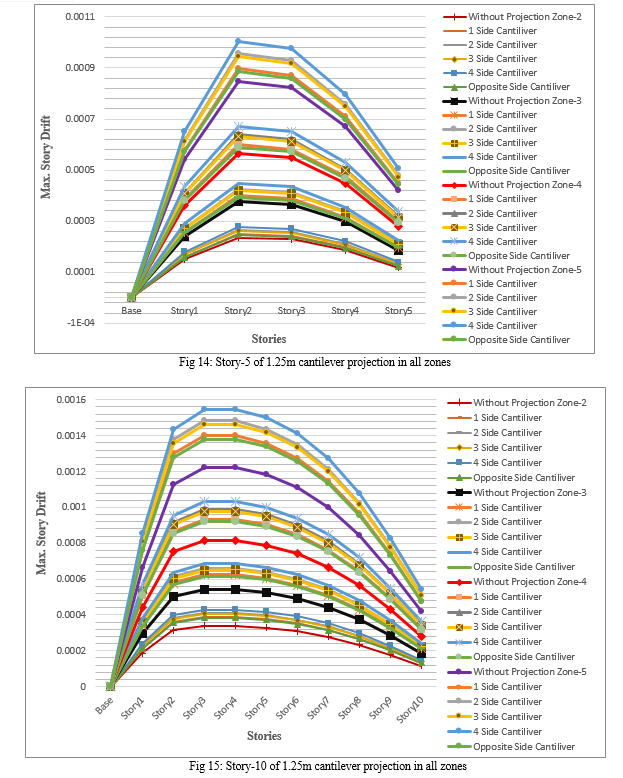
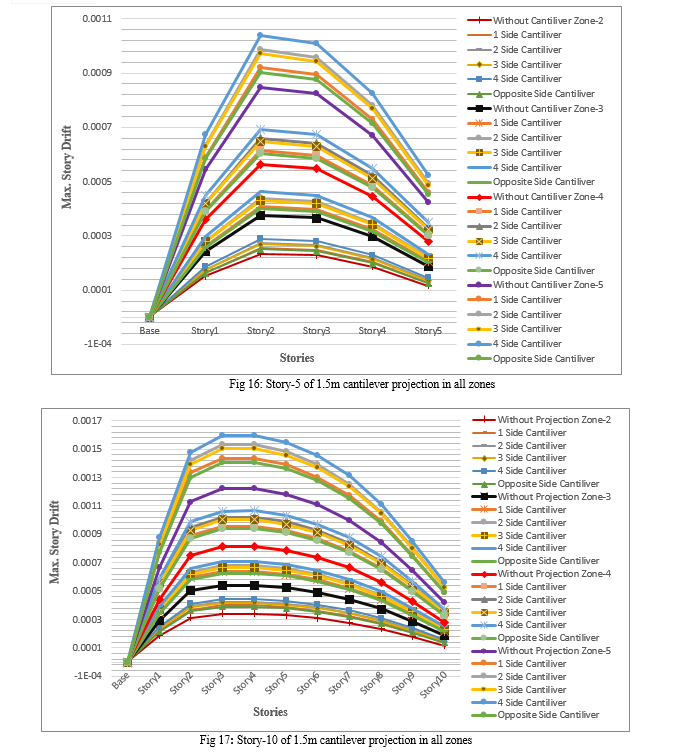
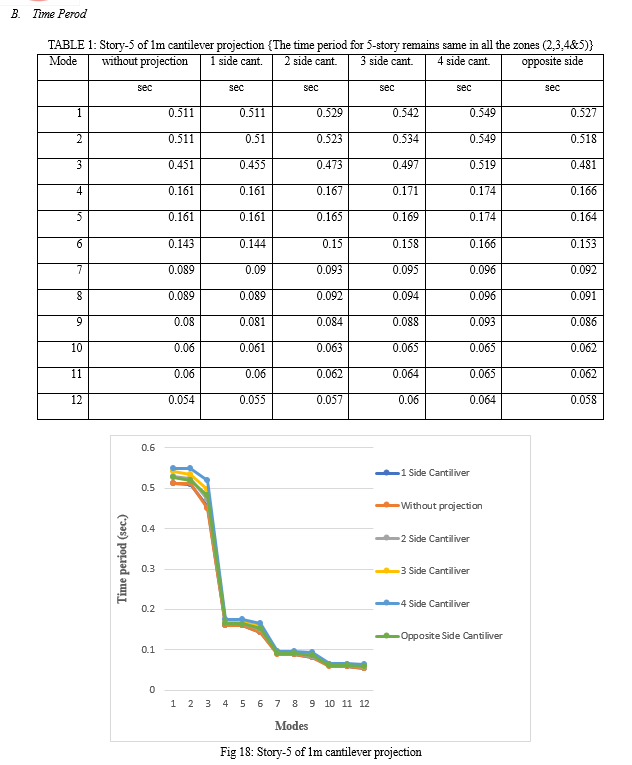
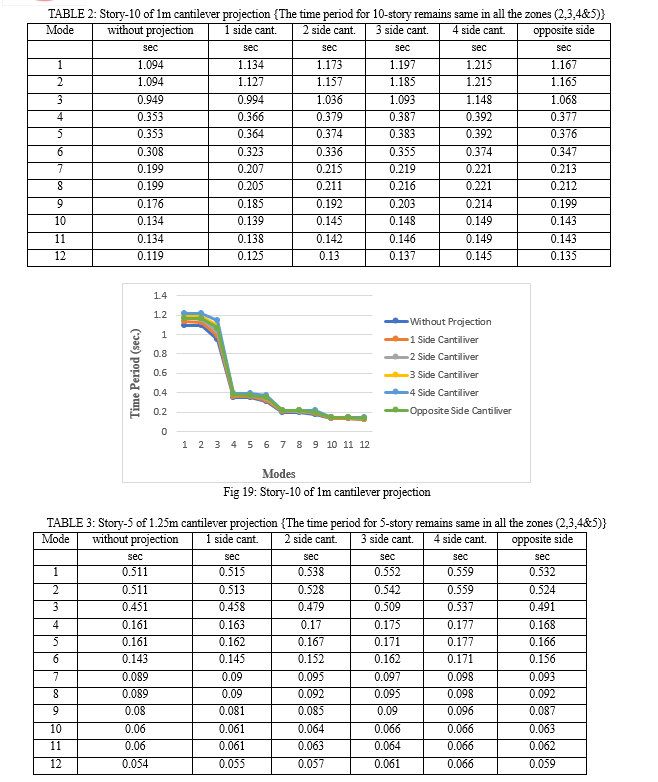

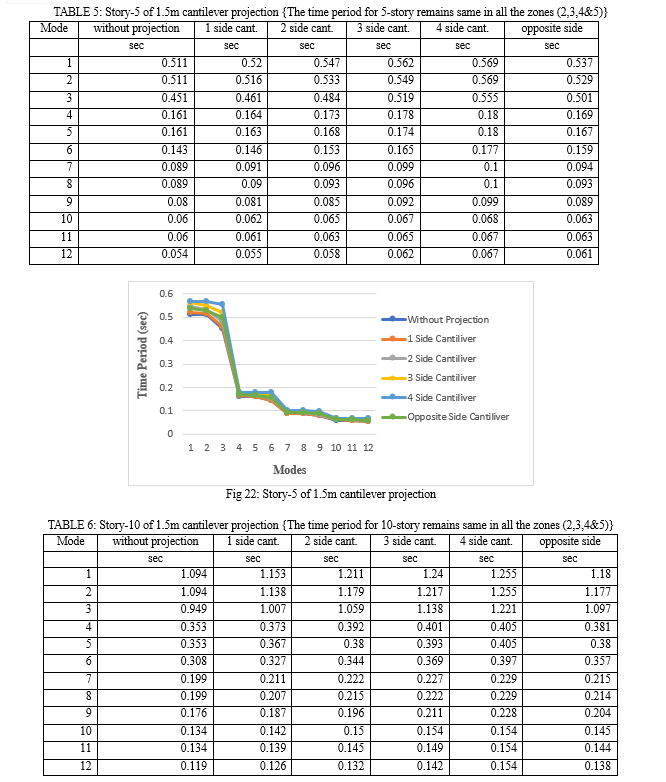





VI. ACKNOWLEDGMENT
I am thankful to my guide, Dr. Umesh Pendharkar in Civil Engineering Department for his constant encouragement and able guidance. Also, I thank my parents, friends etc. for their continuous support in making this work complete.
Conclusion
A. Story Drift 1) 1m Cantilever Projection With increase in height of the building with top floor story drift increases- • When cantilever is on one side story drift at top increases by 3% for 5-storied building whereas it increases by 12% for 10-storied building. The top floor story drift increases with cantilever projection on one side. • When cantilever is on two side story drift at top increases by 9% for 5-storied building whereas it increases by 17% for 10-storied building. The top floor story drift increases with cantilever projection on two side. • When cantilever is on three side story drift at top increases by 8% for 5-storied building whereas it increases by 17% for 10-storied building. The top floor story drift increases with cantilever projection on three side. • When cantilever is on four side story drift at top increases by 14% for 5-storied building whereas it increases by 22% for 10-storied building. The top floor story drift increases with cantilever projection on four side. • When cantilever is on opposite side story drift at top increases by 2% for 5 storied building whereas it increases by 13% for 10-storied building. The top floor story drift increases with cantilever projection on opposite side. The top floor story drift increases with cantilever projections on all sides and in all zones. 2) 1.25m Cantilever Projection With increase in height of the building with top floor story drift increases- • When cantilever is on one side story drift at top increases by 6% for 5-storied building whereas it increases by 10% for 10-storied building. The top floor story drift increases with cantilever projection on one side. • When cantilever is on two side story drift at top increases by 5% for 5-storied building whereas it increases by 21% for 10-storied building. The top floor story drift increases with cantilever projection on two side. • When cantilever is on three side story drift at top increases by 11% for 5-storied building whereas it increases by 19%-20% for 10-storied building. The top floor story drift increases with cantilever projection on three side. • When cantilever is on four side story drift at top increases by 18% for 5-storied building whereas it increases by 26% for 10-storied building. The top floor story drift increases with cantilever projection on four side. • When cantilever is on opposite side story drift at top increases by 4% for 5 storied building whereas it increases by 13% for 10-storied building. The top floor story drift increases with cantilever projection on opposite side. The top floor story drift increases with cantilever projections on all sides and in all zones. 3) 1.5m Cantilever Projection With increase in height of the building with top floor story drift increases- • When cantilever is on one side story drift at top increases by 8% for 5-storied building whereas it increases by 17% for 10-storied building. The top floor story drift increases with cantilever projection on one side. • When cantilever is on two side story drift at top increases by 16% for 5-storied building whereas it increases by 25% for 10-storied building. The top floor story drift increases with cantilever projection on two side. • When cantilever is on three side story drift at top increases by 14% for 5-storied building whereas it increases by 23% for 10-storied building. The top floor story drift increases with cantilever projection on three side. • When cantilever is on four side story drift at top increases by 22% for 5-storied building whereas it increases by 30% for 10-storied building. The top floor story drift increases with cantilever projection on four side. • When cantilever is on opposite side story drift at top increases by 6% for 5 storied building whereas it increases by 15% for 10-storied building. The top floor story drift increases with cantilever projection on opposite side. The top floor story drift increases with cantilever projections on all sides and in all zones. B. Time Period 1) 1m Cantilever Projection With increase in height of the building the time period increases- • When cantilever is on one side time period increases by 0% for 5-storied building whereas it increases by 3% for 10-storied building. The time period increases with cantilever projection on one side. • When cantilever is on two side time period increases by 3% for 5-storied building whereas it increases by 7% for 10-storied building. The time period increases with cantilever projection on two side. • When cantilever is on three side time period increases by 6% for 5-storied building whereas it increases by 9% for 10-storied building. The time period increases with cantilever projection on three side. • When cantilever is on four side time period increases by 7% for 5-storied building whereas it increases by 11% for 10-storied building. The time period increases with cantilever projection on four side. • When cantilever is on opposite side time period increases by 3% for 5 storied building whereas it increases by 6% for 10-storied building. The time period increases with cantilever projection on opposite side. The time period increases with cantilever projections on all sides and in all zones. 2) 1.25m Cantilever Projection With increase in height of the building the time period increases- • When cantilever is on one side time period increases by 0.78% for 5-storied building whereas it increases by 4% for 10-storied building. The time period increases with cantilever projection on one side. • When cantilever is on two side time period increases by 5% for 5-storied building whereas it increases by 8% for 10-storied building. The time period increases with cantilever projection on two side. • When cantilever is on three side time period increases by 8% for 5-storied building whereas it increases by 11% for 10-storied building. The time period increases with cantilever projection on three side. • When cantilever is on four side time period increases by 9% for 5-storied building whereas it increases by 12% for 10-storied building. The time period increases with cantilever projection on four side. • When cantilever is on opposite side time period increases by 4% for 5 storied building whereas it increases by 6% for 10-storied building. The time period increases with cantilever projection on opposite side. The time period increases with cantilever projections on all sides and in all zones. 3) 1.5m Cantilever Projection With increase in height of the building the time period increases- • When cantilever is on one side time period increases by 1% for 5-storied building whereas it increases by 5% for 10-storied building. The time period increases with cantilever projection on one side. • When cantilever is on two side time period increases by 7% for 5-storied building whereas it increases by 10% for 10-storied building. The time period increases with cantilever projection on two side. • When cantilever is on three side time period increases by 9% for 5-storied building whereas it increases by 13% for 10-storied building. The time period increases with cantilever projection on three side. • When cantilever is on four side time period increases by 11% for 5-storied building whereas it increases by 14% for 10-storied building. The time period increases with cantilever projection on four side. • When cantilever is on opposite side time period increases by 5% for 5 storied building whereas it increases by 7% for 10-storied building. The time period increases with cantilever projection on opposite side. The time period increases with cantilever projections on all sides and in all zones. C. Frequency 1) 1m cantilever projection With increase in height of the building the frequency increases- • When cantilever is on one side frequency increases by 0.87% for 5-storied building whereas it increases by 4% for 10-storied building. The frequency increases with cantilever projection on one side. • When cantilever is on two side frequency increases by 4% for 5-storied building whereas it increases by 8% for 10-storied building. The frequency increases with cantilever projection on two side. • When cantilever is on three side frequency increases by 9% for 5-storied building whereas it increases by 13% for 10-storied building. The frequency increases with cantilever projection on three side. • When cantilever is on four side frequency increases by 15% for 5-storied building whereas it increases by 18% for 10-storied building. The frequency increases with cantilever projection on four side. • When cantilever is on opposite side frequency increases by 7% for 5 storied building whereas it increases by 11% for 10-storied building. The frequency increases with cantilever projection on opposite side. The frequency increases with cantilever projections on all sides and in all zones. 2) 1.25m Cantilever Projection With increase in height of the building the frequency increases- • When cantilever is on one side frequency increases by 1% for 5-storied building whereas it increases by 4% for 10-storied building. The frequency increases with cantilever projection on one side. • When cantilever is on two side frequency increases by 5% for 5-storied building whereas it increases by 9% for 10-storied building. The frequency increases with cantilever projection on two side. • When cantilever is on three side frequency increases by 11% for 5-storied building whereas it increases by 14% for 10-storied building. The frequency increases with cantilever projection on three side. • When cantilever is on four side frequency increases by 17% for 5-storied building whereas it increases by 20% for 10-storied building. The frequency increases with cantilever projection on four side. • When cantilever is on opposite side frequency increases by 8% for 5 storied building whereas it increases by 12% for 10-storied building. The frequency increases with cantilever projection on opposite side. The frequency increases with cantilever projections on all sides and in all zones. 3) 1.5m Cantilever Projection With increase in height of the building the frequency increases- • When cantilever is on one side frequency increases by 1% for 5-storied building whereas it increases by 5% for 10-storied building. The frequency increases with cantilever projection on one side. • When cantilever is on two side frequency increases by 6% for 5-storied building whereas it increases by 9% for 10-storied building. The frequency increases with cantilever projection on two side. • When cantilever is on three side frequency increases by 12% for 5-storied building whereas it increases by 16% for 10-storied building. The frequency increases with cantilever projection on three side. • When cantilever is on four side frequency increases by 19% for 5-storied building whereas it increases by 22% for 10-storied building. The frequency increases with cantilever projection on four side. • When cantilever is on opposite side frequency increases by 10% for 5 storied building whereas it increases by 13% for 10-storied building. The frequency increases with cantilever projection on opposite side. The frequency increases with cantilever projections on all sides and in all zones.
References
[1] Pawan R. Thakare, “Analysis of G+15 High Rise Building by Using Etabs for Various Frame Sections in Zone II and Zone III”, International Journal of Innovative Research in Technology (IJIRT), Vol. 8, Issue 12, May 2022, pp. 988-997. [2] Ankit Purohit, Lovish Pamecha, “Seismic Analysis of G+12 Multistory Building Varying Zone and Soil Type”, SSRG International Journal of Civil Engineering (SSRG-IJCE), Vol. 4, Issue 6, June 2017, pp. 79-85. [3] Arunava Das, Priyabrata Guha, “Comparative Study of the Static and Dynamic Seismic Analysis of RC regular and irregular frame structures”, International Journal of Scientific & Engineering Research (IJSER), Vol. 7, Issue 4, April 2016, pp. 25-28. [4] Gourav B N, Darshan G S, Ganesh M Gaonkar, HP Senani, “Analysis of High-Rise Structures in Different Seismic Zones for Soil Type 1”, International Journal of Scientific Research and Engineering Development (IJSRED), Vol. 4, Issue 3, May-June 2021, pp. 129-136. [5] Sampath Nagod, Prof. A.J. Zende, “SEISMIC ANALYSIS OF MULTISTOREYED RC BUILDING Birthright TO MASS IRREGULARITY in TIME HISTORY ANALYSIS”, International Research Journal of Engineering and Technology (IRJET), Vol. 4, Issue 8, August 2017, pp. 621-625. [6] Raju Muddasani, Navjot Kaur Bhatia, “Seismic Analysis of Multi-Story RCC Structure Having Vertical Irregularity in Different Locations”, International Journal of Creative Research Thoughts (IJCRT), Vol. 11, Issue 4, April 2023, pp. 898-905. [7] Dr. K. Chandrasekhar Reddy, G. Lalith Kumar, “Seismic Analysis of High-Rise Buildings (G+30) by Using ETABS”, International Journal of Technical Innovation in Modern Engineering & Science (IJTIMES), Vol. 5, Issue 3, March 2019, pp. 174-181. [8] Mindala Rohini, T. Venkat Das, “Seismic Analysis of Residential Building for Different Zones using ETABS”, International Journal of Recent Technology and Engineering (IJRTE), Vol. 7, Issue 6, April 2019, pp. 293-298. [9] Shaikh Abbas, Jahesh Sharma, “A Review Paper on: Design and Analysis of G+7 Building Using ETABS”, International Research Journal of Modernization in Engineering Technology and Science (IRJMETS), Vol. 4, Issue 1, January 2022, pp. 783-786. [10] Kaveri, Guramma, Muttamma, Neelamma Kawati, Saksheshwari, “Analysis of a Multi-Storied Building in Different Soil Conditions with Different Seismic Zones of India”, International Journal of Civil Engineering (IJCE), Vol. 6, Issue 5, May 2019, pp. 11-15. [11] K. Prabin Kumar, M. Malyadri, “Seismic Analysis and Design of G+15 Multistorey Residential Building - A Review”, International Journal of Pure and Applied Mathematics, Vol. 119, Issue 17, pp. 211-216. [12] Ravi Kumar Vishwakarma, Vipin Kumar Tiwari, “Seismic Analysis of G+10 Storey Building with Various Locations of Shear Walls Using ETABS”, International Journal for Scientific Research & Development (IJSRD), Vol. 9, Issue 1, 2021, pp. 203-205. [13] Asadullah Dost, Asst. Prof. Anil Kumar Chaudhary, “Seismic Resistant Design and Analysis of (G+15), (G+20) and (G+25) Residential Building and Comparison of the Seismic Effects on Them”, International Journal of Innovative Research in Technology (IJIRT), Vol. 8, Issue 1, June 2021, pp. 102-112. [14] Kusuma. S, Dr. E. Ramesh Babu, “Seismic Analysis of Multistory Building Using ETABS with Comparison of Response Spectrum Method and Time History Method”, Journal of Emerging Technologies and Innovative Research (JETIR), Vol. 7, Issue 5, May 2020, pp. 711-720. [15] Rinkesh R Bhandarkar, Utsav M Ratanpara, Mohammed Qureshi, “Seismic Analysis & Design of Multistory Building Using ETABS”, International Journal of Engineering Development and Research (IJEDR), Vol. 5, Issue 2, 2017, pp: 78-90. [16] Sanisha Santhosh, Linda Ann Mathew, “Seismic Analysis of Multi Fabled structure with Shear Walls of Different Shapes”, International Journal of Engineering Research & Technology (IJERT), Vol. 6, Issue 6, June 2017, pp: 490-494. [17] Shobha R, Vinod BR, Vivek Vedant, Jagdish Suthar B, Pawan Bhatia, Joell Binu P, “Seismic Analysis of Multi-Storey Structure Subjected To Different Ground Motions”, Turkish Journal of Computer and Mathematics Education, Vol. 12, Issue 10, 2021, pp. 6888-6904. [18] Suvradeep Saha, “Projection Effect on Seismic Response of Square Symmetric Structure”, International Research Journal of Engineering and Technology (IRJET), Vol. 5, Issue 4, April 2018, pp. 1394-1403. [19] IS 1893 (Part 1): 2016, Criteria for Earthquake Resistant Design of Structures, Part-1 General Provisions and Buildings (Sixth Revision).
Copyright
Copyright © 2023 Dhanshree Nandanwar, Dr. Umesh Pendharkar. This is an open access article distributed under the Creative Commons Attribution License, which permits unrestricted use, distribution, and reproduction in any medium, provided the original work is properly cited.

Download Paper
Paper Id : IJRASET55991
Publish Date : 2023-10-03
ISSN : 2321-9653
Publisher Name : IJRASET
DOI Link : Click Here
 Submit Paper Online
Submit Paper Online

